|
Trumpeter's 1/72 scale
Wellington GR.XIV
by Mark Davies
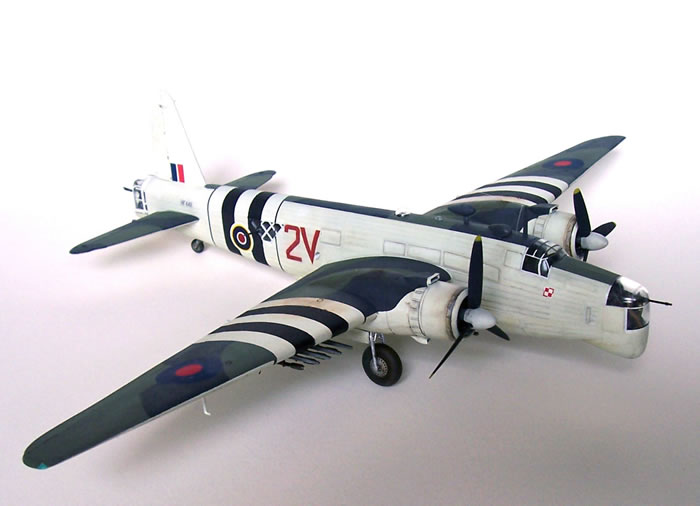
|
Wellington GR.XIV |

Trumpeter's 1/72 scale Wellington GR.XIV is available online from Squadron.com
The Vickers Wellington really needs no introduction, and was the most widely produced British bomber off WW2. It saw frontline service in a variety of capacities from the beginning to end of the conflict. These included day and night bomber, torpedo bomber, high altitude bomber, maritime and anti-submarine patrol, transport, trainer and engine test-bed. It continued to serve in non-combat roles for some time after the war. One thing it wasn’t suited to however was towing gliders, as its geodetic construction meant it would stretch!
The Mk XIV was the culmination of a series of maritime patrol and anti-submarine versions. It was equipped with ASV Mk III radar in a chin installation, a retractable ventral Leigh searchlight, and had the ability to carry eight RP-3 rocket projectiles as well as depth charges etc.
Background to My Build
My regular bunch of modelling mates and I get together each Friday taking turns to host. We have a few (or several) drinks, plenty of laughs, and even occasionally view and discuss our models after putting the world to rights.
Anyway, we agreed to each to build a twin-engined plane between December 1st 2009 and the last Friday of January 2010. One of my mates quickly got on with two MPM Wellingtons a Mk X and a Mk II. Upon seeing them on the second Friday of December I was reminded how much I liked the Wellington, and so decided to build one of mine. To avoid being a complete copycat I chose my Trumpeter GR XIV to build. I had seen the same mate build a 1/48 Trumpeter Wellington for a commission, and thought the very similar 1/72 kit would make for a fairly straightforward build. (More fool me as it happens.)
Quarter Scale Wellington’s Little Brother
The 1/72 Trumpeter Wellington kits are in many respects scaled down versions of their 1/48 offerings, and as such have many of the same good and bad points. The following observations apply equally to their Mk IC, Mk III, MK X and Mk XIV. For a in-box review see Brett Green’s ”First Look” article.
Pros:
-
Exceptional levels of internal detail for the scale (although sadly most of this is unobservable in the confines of the dark fuselage).
-
The best gun-turret internal detail I have encountered in a 1/72 kit.
-
Well-captured fuselage structure (although some diamond-shaped panels are far too prominently raised and need sanding down).
-
Good bomb-bay internal detail for this scale (although no weapons are provided).
-
Generally good lines.
-
Excellent wheel-well detail, both main and tail.
Cons:
-
In my opinion, ridiculously exaggerated geodetic effect on the flying surfaces. This effect is so overdone the plane would not fly if the real thing had sagging fabric like the kit’s representation. I checked hundreds of photos, and with one or two exceptions of in-flight aircraft photographed in low angle sunlight, I could not observe the geodetic structure through the fabric. I thought the MPM/Italeri Wellingtons were overdone, but Trumpeter has really made for some extra work here. See the photo of four wings, being top to bottom: Trumpeter scraped, filled and sanded, untouched Trumpeter, MPM/Italeri, and Matchbox/Revell. Matchbox is the best in my view. (It’s interesting to note the variation in outlines and the bulk the different brands give to the engine nacelles.)
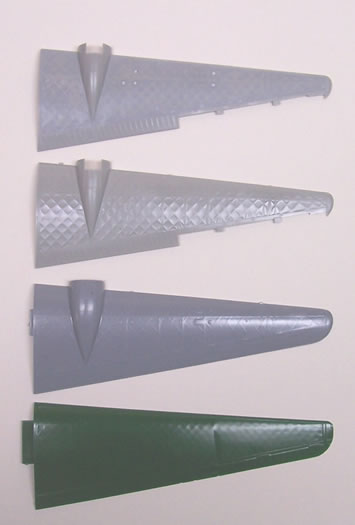
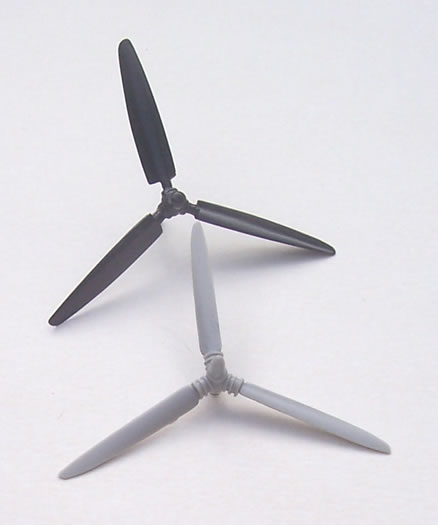
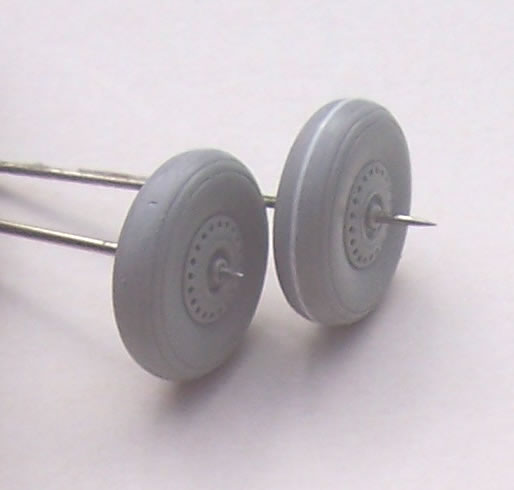
Faults & Weaknesses Specific to the Trumpeter GR XIV:
-
A radar chin that is too long and prominent in my opinion.
-
The nose transparency framing is simply wrong in angle and layout, and the proportions of the clear section are wrong in that they are too deep on the sides. (Both nose accuracy faults seem to mirror the Matchbox/Revell kit’s GR XIV parts)
-
The under-wing panels for the RP-3’s are not represented.
-
Whilst the rest of the kit has exceptional interior detail where you won’t be able to see most of it, there is no internal detail in the nose area where you will see it!
The Best Laid Plans…
My plan of attack for this quick build was essentially:
-
Fill the over-done geodetic wing-pox effect with Mr Surfacer.
-
Knock up some interior detail for the nose.
-
Swap the props for those off my Matchbox kit (if I’d had time I would have ordered some Rotols from Aeroclub)
-
Fatten the wheels.
-
Add RP-3 underwing load-bearing panels and get some rocket projectiles.
-
Sand off the nose and cockpit canopy framing.
-
Assume that the interior detail would be seen, and then see how much could be seen as a guide to future Wellington builds.
-
Choose an interesting colour scheme.
Now you may have spotted a major mistake in my plan. Yes, I was to start building, painting and bashing away before I’d chosen the actual aircraft I wished to model – not the smartest move I know.
Curing Wing-Pox….
In preparation for the reduction of the surface detail, I drilled out the fuel filler caps in the wings and rebated the holes a little. I then inserted plastic rod into the holes to be flush with the wings. I thus had caps that would remain as I filled and sanded back the surface detail. Having glugged my way through most of my bottle of Mr Surfacer on my test wing I realised more drastic action was called for. In the end I scraped away the excessive spar lines and filled much of the geodetic effect with Tamiya putty. I then sanded and Mr Surfacered, and kept sanding and Mr Surfacering until I had hidden most of the pox-scars in the flying surfaces. I also added navigation lights to the wing tips made from coloured toothbrush handles.

What’s in its nose?
I examined heaps of external photos of GR XIV noses and failed to confirm what the interior looked like. My only reference in the end was an old cutaway drawing showing a seat, ammo-boxes and spent-case collection chute for a twin Browning .303 installation. I therefore made a floor, extended the kit’s geodetic framing onto the plain interior surfaces and would decide on adding a gun or guns later once I chose my subject.

Pointless Painting
I decided I had better get on and paint the interior. Different aircraft appear to have had some colour variation as far as the interior is concerned. The photos show what I settled on. Let me say that this interior took quite a while to paint, and I persisted despite my better judgement which told me not enough light would penetrate for it to be seen. As it turned out I was right, and little could be seen.
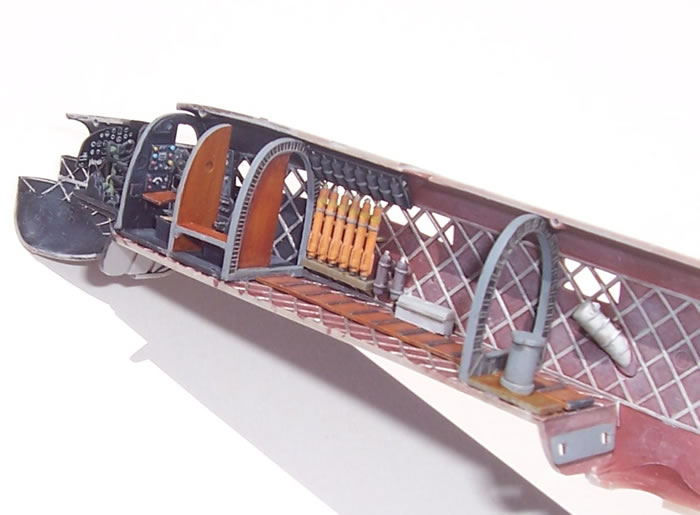
It’s worth mentioning at this point that Trumpeter’s moulding of the geodetic structure in within the window frames makes for a slightly over-scale appearance. I feel it would have been better to mould more delicate detail onto the glazing itself.
Before closing the fuselage halves I added a representation of the Leigh light using a pen tube and some channel section plastic inside the fuselage. I chopped the barrels off the beam guns and added their receiver mechanisms to their mounts. The mounts and their reflector sights could be improved for scale appearance, but I didn’t due to time constraints and the fact that they are hard to see. I also drilled holes above the bomb-bay doors for the bomb winch crank mechanisms.
A feature that is very well captured is the pilot’s seat (I understand it was considered the most comfortable of British bomber seats). I added some PE belts to this as I knew they would be visible. Initially I was surprised and felt let down by a flat instrument panel and a decal for instruments, given the high levels of moulded interior detail elsewhere. I the end however the decaled panel was quite sufficient for the scale.
Anyway, I spent far too long wasting my time painting the interior, especially when late in the build I realised that the plane I chose to model had over-painted fuselage windows! This wasted time was to place some pressure on me later on. Normally I wouldn’t let a deadline cause me to rush spoil a model, as I’m quite capable of doing that as a matter of course. However within my modelling group I have never lived down the fact that I’m about nine years overdue on a team B-17 build, so I felt I should have this one done by the end of January.
The Airframe Comes Together
With fuselage together I was itching to see what it looked like with the wings on. To be honest I would have preferred for the ailerons to be moulded with the wings. Separate items just added to the complexity, although I know some would be happy to be able to displace these surfaces. With all of the flying surfaces clipped into place I got a big motivational boost as it really began to look like a Wellington. This was sufficient for a couple of banks and low-level run over the modelling bench accompanied by aeroplane noises (at nearly 50 I’m close enough to a second childhood to get away with this!).
It was time to get on with the engines. The kit provides two quite nice representations of Hercules engines, along with separate collector ring, cowl, cooling flaps and nacelle front. The kit also contains the equivalent items for the earlier Pegasus powered versions. I found that the fit of the various cowling and nacelle parts was not the best, which is a pity as some rather nice surface detail is featured here. I’ve already mentioned that the props are far too skinny, but feel I should mention it again, as it’s pretty poor not to get them right.
I took the opportunity to thin the openings to the carburettor intakes and oil coolers, and I drilled out the exhausts and fuel dump pipes. I was worried that the cowling interiors might look a little empty, especially as I feel the engines sit a little far back. I therefore made a simplified representation of the exhaust manifold using solder. As it turns out this was also a waste of time as little can be seen.
Those Underwing Rockets
Although the Wellington GR XIV was equipped to carry RP-3 rockets its hard to find photos of them doing so. I found three or four. Two of the best feature what I think must be a test aircraft. What is very apparent on this aircraft are large grey (?) panels extending forward from the flaps to the main spar, and outboard from the nacelles to the ailerons. The fact that they are much darker than the white under-surfaces suggest this is a test machine, as they nullify the white camouflage’s effectiveness. At first it might be assumed that these panels are intended to protect the fabric wing from the flame of the rocket motors. However the shape and extent of the panels either side of the rocket batteries suggest to me that they are intended to provided an attachment for the rockets that spreads the load over a wide are of the geodetic wing structure. I assume that this would be needed in the absence of conventional ribs for load-bearing attachment points.
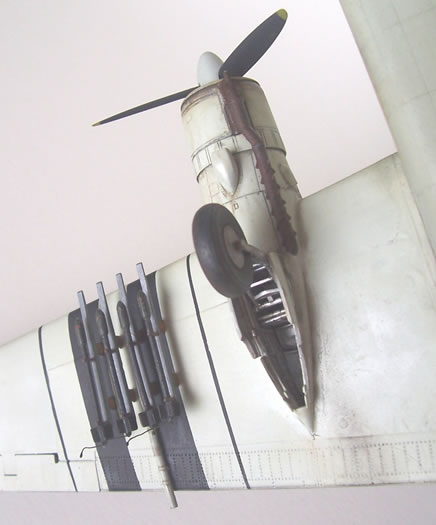
I made my panels from self adhesive aluminium tape, and painted them white as I observed them to be in a photo of an operational machine. My rockets came from an Academy Typhoon. The rush to finish is my excuse for not replacing those over-scale rocket fins. I added some firing wires hanging down, but probably need to trim a couple of millimetres off each now that I look at them again in the photos.
The photos of rocket carrying GR XIV’s I found wore slightly boring paint schemes. However I had found some very attractive schemes in an excellent French publication called Air Mag Hors Serie, Numero 7. Air Mag is published by a Spanish guy called Jose Fernandez. Based in Paris, Jose is also behind Azur brand kits produced by the MPM Group. I chose a scheme with D-Day stripes, nose gun, twin DF footballs, and as I have mentioned already, painted over fuselage windows! I have no idea if this one carried rockets or not, but it could have. So that was good enough for me. After all that’s modelling for you, your model can be finished whatever you want.
More Nose Picking
I knocked up a nose gun from a spare in the kit, and made the link and case collector chute from solder and fuse wire. I sourced another DF loop from my spares (donated by an Academy B-17C/D) which are possibly a little small, but I can live with it.
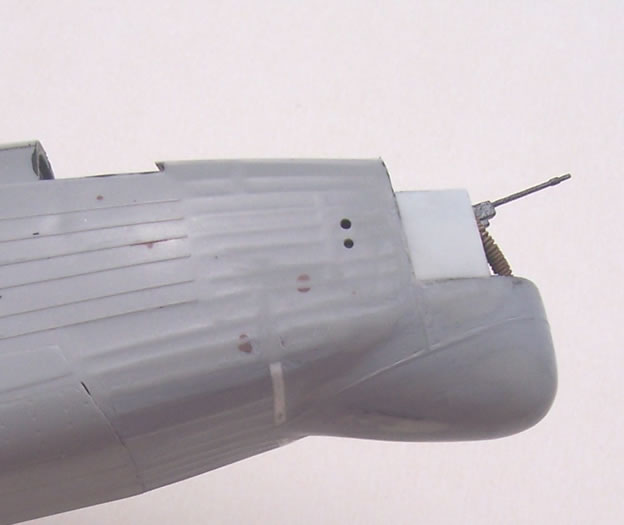
Around about this point I also extended the panels either side of the nose to give the correct proportions between the clear glazing and the fuselage. This required sanding down the kit panels and replacing them with thin plastic card. It was around this time that I realised that the chin radome looked to long and bulky. I hacked away at it until I was left with a hole to fill with plastic card after running out of kit plastic. I reconstructed some fabric surface detail between the bomb-bay and radar chin, and also let in a small raised line of stretched sprue around the chin, as photos showed this to be anything but a smooth transition from the fuselage.
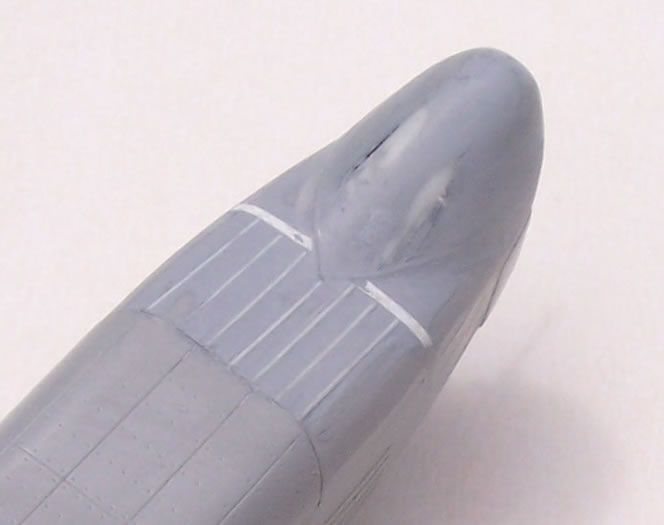
Odds and Sods
Before addressing painting, the other constructional tasks to be finished included:
-
Thickening the main wheels with plastic card discs.
-
Assembling the rear turret per the instructions (the spent link and case chutes could do with being replaced with thinner more to scale items, but I did not have time)
-
Attaching the two DF loops and thinned down antenna mast.
-
Detailing the bottom of the Leigh light based on what I could see in photos.

Camouflage & Weathering
Painting was done with the wings and tailplane detached which made painting a lot easier. I chose to paint the fuselage in an off-white to allow later highlighting with fresher white sprayed on and oil paint filters (to use AFV modelling parlance). It would also enable the D-Day stripes to look fresher compared to the older white airframe finish. I chose to use acrylics mainly to make using oil washes and filters simpler, and in part for selection of colours from existing paint stocks. The off-white, white and dark sea-grey were by Gunze, and the dark slate grey was Tamiya’s RLM Grey.
I studied many photos of Coastal Command Wellingtons and whilst some were clean, many did get quite dirty. I tried for a middle ground. I noted where the fuselages seemed to get grubby below the cockpit and along the bomb-bay, presumably from armourers’ hands etc. Also I allowed for fuel spills and dirt on the wings, and of course oil stains from the engines. One thing I found interesting when reviewing photos was that GR XIV’s had their exhaust collector rings painted white, and that this paint did not necessarily burn away, although in some cases it became very discoloured. I tried to reflect this using oil paints, graphite dust and pastels.
D-Day Stripes
D-Day stripes could be applied precisely or as rough as guts and photo evidence can always be found to prove either case. I feel that even fairly rough unmasked 1:1 paint jobs would look pretty straight in 1/72 scale. After all, a 3” real-life wobble in a line would reduce to just less than 1 mm on the model. The Wellington photos I saw with D-day stripes looked pretty tidy, and as I only had artwork of my plane I had no photographic evidence to guide me. I chose to go with hard masking as I find it more attractive on a model. Maybe not the best rationale, but I only have to please myself right?
Decals & Detail Bits
The wing roundels, fins flashes and Polish insignia were kit decals. The kit’s fuselage roundels were out of register, so donors were found. I must thank a couple of my modelling mates the squadron codes and serial numbers: Peter Mossong for the graphics, and Martin Short for printing. Pre-painted decal strip served to frame the two sanded smooth canopies and the beam-gun windows. The tail turret was masked. The exhausts had a combination of paint and ground pastel mixed with oil paints. The airframe had various oil paint filters smeared around to create some variation in colours everything was dulled down with household mat varnish.
This build was anything but straightforward, but I’m happy with the result. It’s hard to see in the photos, but the geodetic patterns are just discernible under the paint, and are similar to those on the Matchbox/Revell Wellington. If it were not for the surface detail and nose shape errors (in my opinion) I would give Trumpeter some very high marks for their GR XIV.
Now that I have built this kit I feel I will do a better and quicker job of my other Trumpeter Wellingtons (one will have Matchbox wings). I also look forward to having a crack at my two MPM Wellington kits. After all, there is something very appealing about the Wellington. To me it’s a bit like the SM 79, individual component shapes suggest it should be ugly, but as a whole the proportions and combination of shapes are handsome bordering on beautiful. Go build one!
Models, Description and Images Copyright © 2010 by Mark Davies
Page Created 4 April, 2010
Last Updated
5 April, 2010
Back to HyperScale
Main Page

|
Home
| What's New |
Features |
Gallery |
Reviews |
Reference |
Forum |
Search